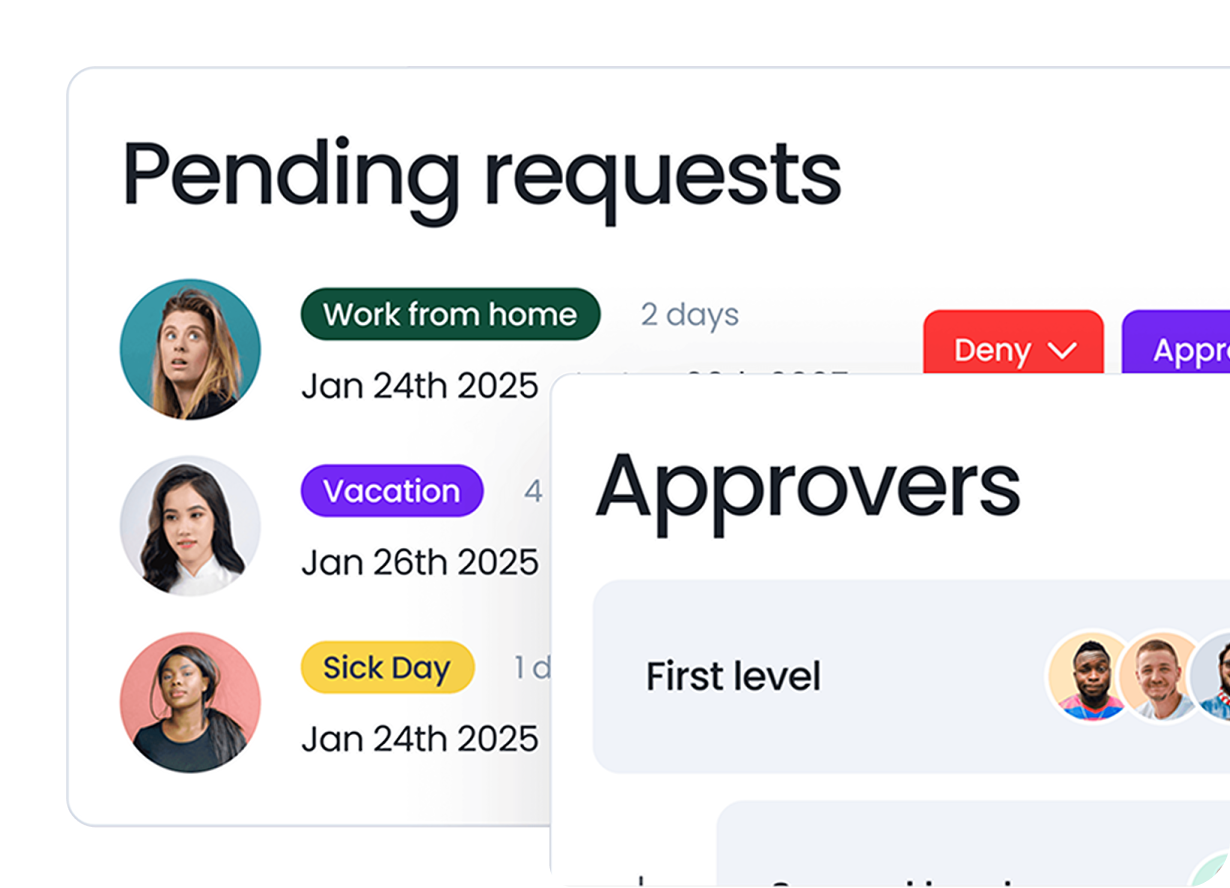Last updated on August 29, 2025
Managing time off in distributed teams is both an art and a science. On one hand, you want your employees to take the breaks they need to recharge and avoid burnout. On the other, you must ensure smooth operations, coverage, and fairness, without endless back-and-forth emails or spreadsheets.
This guide explores the challenges, best practices, and strategies for managing time off in distributed teams. It draws from real-world experiences, making it a guide “built by one”, a single distributed team navigating the same struggles most companies face.
Why Managing Time Off in Distributed Teams Is Different
When your team shares the same office and time zone, handling time off is fairly simple. A manager posts a vacation calendar on the wall, employees submit their requests, and everyone can see who’s out on any given day. But in distributed teams, things are rarely that straightforward.
Different Time Zones
Distributed teams span countries, and often continents. A holiday in Toronto may be a regular workday in Tokyo. A “day off” for someone in London might overlap with only part of the workday for a colleague in New York. This makes scheduling coverage and collaboration much more complex.
Cultural and Legal Variations
Leave laws differ across countries. While U.S. employees may get 10 paid vacation days, French employees are legally entitled to at least five weeks. On top of this, public holidays vary dramatically. Distributed teams must balance fairness while staying compliant with local regulations.
Visibility and Communication Challenges
In distributed teams, it’s not always obvious who is working and who isn’t. Miscommunication can easily occur when someone is unexpectedly unavailable. If you don’t have a centralized system, you risk project delays and frustrated teammates.
Risk of Burnout
Remote workers often blur the lines between personal and professional life. Without proactive encouragement to take time off, employees may avoid vacations altogether, leading to disengagement and burnout.
The Business Case for Better PTO Management
Efficient leave management isn’t just a nice-to-have. It directly impacts productivity, retention, and employee satisfaction.
Improved Productivity
When managers know who’s available, projects can be planned realistically, deadlines set fairly, and resources allocated properly.
Stronger Employee Retention
Time off is a cornerstone of employee well-being. A transparent and supportive leave policy shows that you value your team, helping to retain top talent.
Compliance and Risk Mitigation
With employees spread across jurisdictions, mismanaging leave laws could expose your company to compliance risks. Having a structured system avoids costly mistakes.
Team Harmony
Fair, transparent leave tracking ensures nobody feels overworked while others are constantly away. This builds trust and prevents resentment.
Common Pitfalls in Managing Time Off for Distributed Teams
Even the most well-meaning managers fall into common traps.
Relying on Spreadsheets
While spreadsheets may work for a small team, they quickly become unmanageable at scale. They don’t provide visibility, require constant manual updates, and easily lead to errors.
Lack of Centralization
Some companies rely on scattered tools: one manager uses a shared calendar, another tracks in Slack messages, and employees often forget to update statuses. This fragmentation leads to confusion.
Ignoring Local Laws and Holidays
It’s easy to overlook region-specific leave entitlements. But ignoring them not only risks compliance but also damages employee trust.
No Automated Communication
If employees don’t know who is out and when, they waste time chasing unavailable teammates. Automating notifications ensures smoother workflows.
Best Practices for Managing Time Off in Distributed Teams
The challenges are clear, but the solutions are well within reach. Here are best practices that distributed teams can implement immediately.
1. Centralize All Leave Requests
The foundation of good PTO management is a single, unified system. This prevents confusion and ensures managers have the full picture. Vacation Tracker, for example, allows teams to request, approve, and track time off directly in Slack, Microsoft Teams, or through email, no extra logins required.
2. Respect Regional Differences
Document regional entitlements and public holidays. With Vacation Tracker, you can create multiple leave policies for different regions, ensuring compliance without manual tracking.
3. Provide Real-Time Visibility
Everyone on the team should be able to see who is out and when. This reduces unnecessary questions and helps with project planning. With Vacation Tracker you can set automatic daily and weekly notifications, so coworkers know instantly if someone is away.
4. Encourage Employees to Take Time Off
Leaders must actively encourage breaks. Public dashboards and reminders can normalize vacation-taking, ensuring nobody feels guilty or overlooked.
5. Automate Calendar Sync
Integrating time off with shared calendars prevents scheduling conflicts. With Vacation Tracker, approved leave requests can sync directly to Google Calendar, Outlook, or iCal.
6. Plan for Coverage
Encourage managers to assign backups for key responsibilities. This avoids bottlenecks and ensures continuity during absences.
7. Track and Report
Analytics are critical. With detailed reporting, managers can spot patterns, such as teams underutilizing vacation days or employees at risk of burnout. Vacation Tracker provides downloadable reports that can even be used for payroll.
How Vacation Tracker Solves the Problem
Let’s dive deeper into how Vacation Tracker specifically supports distributed teams.
Multi-Platform Integration
Employees don’t need to learn a new tool. They can submit leave requests right from Slack, Teams, or Google Workspace, making adoption seamless.
Policy Customization
You can build policies that reflect each region’s requirements, whether that’s annual leave, sick days, or time off in lieu (TOIL).
Real-Time Notifications
Automatic reminders keep teams updated on upcoming absences, reducing surprises.
Calendar Sync
Every approved leave request can be synced to shared calendars for better visibility.
Advanced Reporting
Managers can generate reports by department, location, or leave type, giving full insight into how time off is being used.
Automated Rollovers and Accruals
Vacation Tracker automates accruals and rollovers, ensuring fairness and compliance without administrative headaches.
Case Study: A Distributed Team in Action
Consider a software development team spread across the U.S., Canada, and Europe. Before implementing Vacation Tracker, they struggled with visibility. Developers often found out too late that colleagues were unavailable, causing project delays.
Once they centralized leave requests with Vacation Tracker:
- Team members submitted requests through Slack.
- Managers approved in seconds without switching platforms.
- Statuses updated automatically, showing availability.
- Regional leave policies ensured compliance in both North America and Europe.
The result? Improved collaboration, fewer misunderstandings, and more balanced workloads. Employees reported higher satisfaction, knowing their time off was tracked fairly and transparently.
Practical Steps to Implement in Your Company
If your team is still juggling spreadsheets or ad hoc systems, here’s a roadmap to implement better leave management.
Audit Current Processes
Identify how requests are submitted, approved, and tracked today.
Define Requirements
Do you need multi-region compliance? Calendar sync? Reporting? Automated accruals?
Choose a Centralized Tool
Adopt a solution like Vacation Tracker that integrates directly into your workflow.
Tracking Can Be
Learn how to manage time off without
confusion, delays, or admin headaches.

Roll Out Policies
Communicate leave entitlements clearly. Transparency builds trust.
Train and Encourage
Show employees how to request time off easily. Encourage managers to lead by example.
Monitor and Adjust
Use reporting to track trends and make policy adjustments where necessary.
The Future of Time Off in Distributed Teams
As distributed work becomes the norm, time off management will only grow in importance. We can expect to see:
AI-Driven Insights: Predicting burnout risks or identifying optimal times for employees to take breaks.
Deeper Integrations: Time off directly impacting project management tools, automatically adjusting timelines.
Wellness-Oriented Policies: Companies offering unlimited PTO or wellness days to prioritize mental health.
At the center of this evolution will be flexible, easy-to-use tools like Vacation Tracker, which ensure fairness and clarity in global teams.
Managing time off in distributed teams doesn’t have to be overwhelming. By centralizing requests, respecting regional differences, providing visibility, and leveraging automation, you can transform a messy process into a seamless one.
Vacation Tracker makes this possible by bringing all aspects of leave management into one intuitive system, built for the way modern distributed teams actually work.
Time off is more than just a scheduling issue, it’s about well-being, fairness, and productivity. When managed right, everyone wins: employees feel valued, managers gain control, and businesses operate smoothly, no matter where their people are.

Aleksandra Cvetkovic
Aleksandra has been with the team since day one, bringing her passion for all things marketing.




